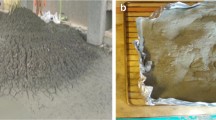Abstract
The objective of this study is to use the unused of textile Effluent Treatment Plant (ETP) sludge in bricks. The physical and chemical and other engineering properties of the ETP sludge from Tirupur are studied. The tests were conducted as per Bureau of Indian Standards (BIS) specification to study the suitability of the ETP sludge for the use of bricks as a structural and non-structural application. The ETP sludge mixed with varying percentages of Flyash failed to meet the compressive strength requirements. The sludge mixed without varying the flyash requirement has met the requirement for the use of bricks. The strength and other durability properties of the bricks met the standards as prescribed by the Indian Standards. It is concluded that the use ETP sludge with quarry dust, flyash, lime and gypsum is possible to manufacture the bricks used for the non-structural applications. In particular, the 10% sludge mixed specimens with quarry dust 30%, flyash 40% after 28 days curing were found to have higher strength of 8.5% when compared with the companion specimens. Through the results obtained in this study, it has been found out that the mixing of ETP Sludge in bricks is beneficial and that it is one of the safest and efficient ways of disposing of the sludge
Access this chapter
Tax calculation will be finalised at checkout
Purchases are for personal use only
Similar content being viewed by others
References
S.S Muthu (eds.).: Environmental Implications of Recycling and Recycled Products, Environmental Footprints and Eco-design of Products and Processes. https://doi.org/10.1007/978-981-287-643-0_9 (2015).
Thomson Jacob. C., Azariah., J. and Viji A.G.R.: Impact of textile industries on river Noyyal and riverine groundwater quality in Tirupur, India. Environment Monitoring Assess, Vol. 18, pp. 359–368 (1999).
Chen Maozhe., Blanc Denise., Gautier Mathieu., Mehu Jacques., Gordon Remy.: Environmental and Technical Assessments of the Potential Utilization of Sewage Sludge Ashes (SSAs) as Secondary Raw Materials in Construction. Waste Management, vol. 33, pp. 1268–1275 (2013).
Ariful Islam Juel., Al Mizan an Tanvir Ahmed.: Sustainable use of tannery sludge in brick manufacturing in Bangladesh. vol. 60, pp. 259–269. http://dx.doi.org/10.1016/j.wasman.2016/12/041.
Vijaya Kishore K.: Utilisation of Sludge Concrete in Paver Blocks. International Journal of Emerging Trends in Engineering and Development, vol. 4, pp. 509–516 (2012).
ASTM C 469 – 10, “Standard Specification for the Coal Fly Ash and Raw or Calcined Natural Pozzolan for Use in Concrete” American Society for Testing and Materials, pp. 1–4.
IS: 712. Specification for building limes. New Delhi: Bureau of Indian Standards; 1973.
IS: 1514. Methods of sampling and test for quick lime and hydrated lime. New Delhi: Bureau of Indian Standards; 1959.
IS: 6932. Methods of Test for building limes. New Delhi: Bureau of Indian Standards; 1973.
IS: 3495-(Part 1). Methods of tests of burnt clay building bricks- Determination of compression strength. New Delhi: Bureau of Indian Standards; 1992.
Raghunathan T., Gopalasamy. P., Elangovan. R.: Study of strength of Concrete with ETP Sludge from Dyeing Industry. International Journal of Civil and Structural Engineering, vol. 1, pp. 379–389 (2010).
Balasubramanian J., Sabumon P. C., John U. Lazar., Ilangovan. R.: Reuse of Textile Effluent Treatment Plant Sludge in Building Material. Waste Management, Vol. 26, pp. 22–28 (2006).
IS: 3495-(Part 2). Methods of tests of burnt clay building bricks- Determination of water absorption. New Delhi, Bureau of Indian Standards; 1992.
Baskar R, Meera Sherrifa Begum. K.M and Sundaram S “Characterization and Reuse of Textile Effluent Treatment Plant Waste Sludge in Clay Bricks”, Journal of the University of Chemical Technology and Metallurgy, Vol. 4, 2006, pp. 473–478.
Kannan Rajkumar P.R, Divya Krishnan K, Sudha C, Ravichandran P.T and Vigneshwaran T.D, “Study on Use of Industrial Waste in Preparation of Green Bricks”, Indian Journal of Science and Technology, Vol. 9, February 2016, pp. 1–6.
Author information
Authors and Affiliations
Corresponding author
Editor information
Editors and Affiliations
Rights and permissions
Copyright information
© 2019 Springer Nature Singapore Pte Ltd.
About this paper
Cite this paper
Ashok Kumar, V.T., Ravichandran, P.T., Kannan Rajkumar, P.R. (2019). Use of Textile Effluent Treatment Plant Sludge as Sustainable Material in Brick Manufacturing. In: Bhaskar, M., Dash, S., Das, S., Panigrahi, B. (eds) International Conference on Intelligent Computing and Applications. Advances in Intelligent Systems and Computing, vol 846. Springer, Singapore. https://doi.org/10.1007/978-981-13-2182-5_27
Download citation
DOI: https://doi.org/10.1007/978-981-13-2182-5_27
Published:
Publisher Name: Springer, Singapore
Print ISBN: 978-981-13-2181-8
Online ISBN: 978-981-13-2182-5
eBook Packages: Intelligent Technologies and RoboticsIntelligent Technologies and Robotics (R0)




